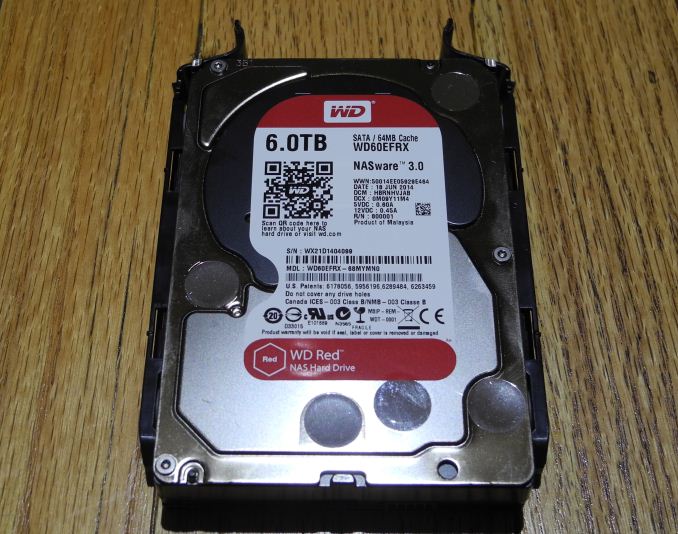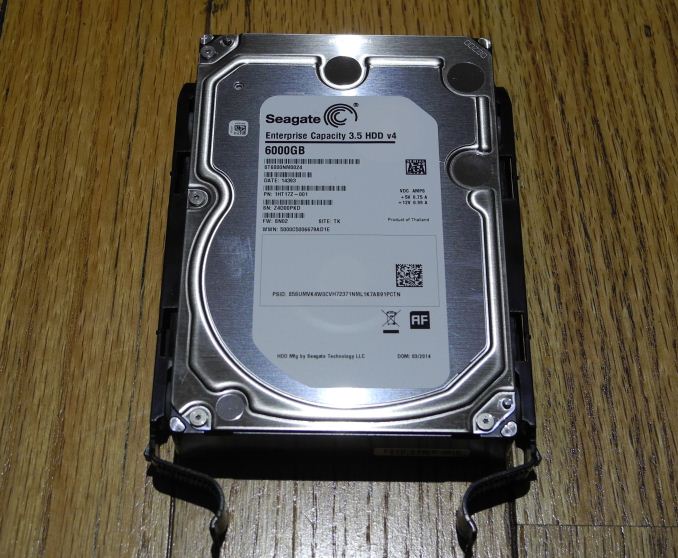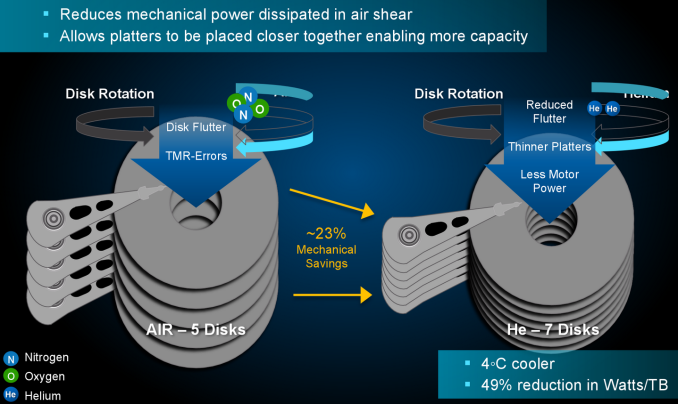6 TB NAS Drives: WD Red, Seagate Enterprise Capacity and HGST Ultrastar He6 Face-Off
by Ganesh T S on July 21, 2014 11:00 AM EST6 TB Face-Off: The Contenders
Prior to getting into the performance evaluation, we will take a look at the special aspects and compare the specifications of the three drives being considered today.
Western Digital Red 6 TB
The 6 TB Red's claim to fame is undoubtedly its areal density. While Seagate went in for a six-platter design for its 6 TB drives, Western Digital has managed to cram in 1.2 TB/platter and deliver a 6 TB drive with the traditional five platter design. The costs are also kept reasonable because of the use of traditional PMR (perpendicular magnetic recording) in these drives.
The 6 TB drive has a suggested retail price of $299, making it the cheapest of all the three drives that we are considering today.
Seagate Enterprise Capacity 3.5 HDD v4 6 TB
Seagate was the first to utilize PMR to deliver a 6 TB enterprise drive earlier this year. They achieved this through the use of a six platters (compared to the traditional five that most hard drives use at the maximum). A downside of using six platters was that the center screw locations on either side got shifted, rendering some drive caddies unable to hold them properly. However, we had no such issues when trying to use the QNAP rackmount's drive caddy with the Seagate drive.
Seagate claims best in class performance, and we will be verifying those claims in the course of this review. Pricing ranges from around $450 on Amazon (third party seller) to $560 on Newegg.
HGST Ultrastar He6 6 TB
The HGST Ultrastar He6 is undoubtedly the most technologically advanced drive that we are evaluating today. There are two main patented innovations behind the Ultrastar He6, HelioSeal and 7Stac. The former refers to placement of the platters in a hermetically sealed enclosure filled with helium instead of air. The latter refers to packaging of seven platters in the same 1" high form factor of traditional 3.5" drives.
With traditional designs, we have seen a maximum of six platters in a standard 3.5" drive. The additional platter is made possible in helium filled drives because the absence of air shear reduces flutter and allows for thinner platters. The motor power needed to achieve the same rotation speeds is also reduced, thereby lowering total power dissipation. The hermetically sealed nature of the drives also allows for immersive cooling solutions (placement of the drives in a non-conducting liquid). This is something not possible in traditional hard drives due to the presence of a breather port.
The TCO (total cost of ownership) is bound to be much lower for the Ultrastar He6 compared to other 6 TB drives when large scale datacenter applications are considered (due to lower power consumption, cooling costs etc.). The main issue, from the perspective of the SOHOs / home consumers, is the absence of a tier-one e-tailer carrying these drives. We do see third party sellers on Amazon supplying these drives for around $470.
Specifications
The various characteristics / paper specifications of the drives under consideration are available in the table below.
| 6 TB NAS Hard Drive Face-Off Contenders | |||
| WD Red | Seagate Enterprice Capacity 3.5" HDD v4 | HGST Ultrastar He6 | |
| Model Number | WD60EFRX | ST6000NM0024 | HUS726060ALA640 |
| Interface | SATA 6 Gbps | SATA 6 Gbps | SATA 6 Gbps |
| Advanced Format (AF) | Yes | Yes | No (512n) |
| Rotational Speed | IntelliPower (5400 rpm) | 7200 rpm | 7200 rpm |
| Cache | 64 MB | 128 MB | 64 MB |
| Rated Load / Unload Cycles | 300K | 600K | 600K |
| Non-Recoverable Read Errors / Bits Read | 1 per 10E14 | 1 per 10E15 | 1 per 10E15 |
| MTBF | 1M | 1.4 M | 2M |
| Rated Workload | ~120 - 150 TB/yr | < 550 TB/yr | < 550 TB/yr |
| Operating Temperature Range | 0 - 70 C | 5 - 60 C | 5 - 60 C |
| Physical Dimensions | 101.85 mm x 147 mm x 26.1 mm. / 680 grams | 101.85 mm x 147 mm x 26.1 mm / 780 grams | 101.6 mm x 147 mm x 26.1 mm / 640 grams |
| Warranty | 3 years | 5 years | 5 years |
The interesting aspects are highlighted above. Most of these are related to the non-enterprise nature of the WD Red. However, two aspects that stand out are the multi-segmented 128 MB cache in the Seagate drive and the HGST He6 drive's lower weight despite having more platters than the other two drives.













83 Comments
View All Comments
ganeshts - Tuesday, July 22, 2014 - link
There is no 6 TB WD Red Pro out in the market. The Pro version tops out at 4 TB (for now) - 800 GB x 5 plattersharshw - Monday, July 21, 2014 - link
This week I had a LaCie 5Big NAS Pro barf on my 4TB Seagate NAS HDDs. Reformatting and re-testing them with sector scans revealed nothing. But the LaCie would claim that one disk was bad. Of course LaCie also claims the 4TB NAS HDDs are completely compatible.But to have a 16TB array die after re-synching 80% and having to start from scratch ... yeah it plain sucks.
So yes, it is best to look at evidence from the field and not just rely on manufacturer's recommended & compatible lists. And it's not just WD Red ...
Hrel - Monday, July 21, 2014 - link
It's frustrating that despite the rapid growth in the NAS industry hard drive prices have remained largely stagnant. 4TB drives are basically at the same price point's they were a year ago. It used to be if a drive was released at $200 a year later it was $100 or less.I'm still waiting for 4TB drives to drop to the $100 mark before I make the jump.
What happened to all those 121TB hard drives that we were supposed to be seeing? I specifically remember an article on anandtech like 1+ years ago talking about how 12TB hard drives would be a reality "a year from today". More than a year later, we're talking about 6TB drives. Very upsetting.
Beany2013 - Tuesday, July 22, 2014 - link
The floods in Thialand a few years ago set things back - we're only now seeing the manufacturers get their primary build locations back up to full speed not just in manufacturing existing gear, but developing new stuff.We've had 2tb drives for *years*, but 3tb and above are the results of the 'HDD Homelands' getting back up to speed as I understand it from my works disty/channel contacts, at least. Mebbe one for a pipeline article on the stagnation of HDD capacity, staffers?
extide - Monday, July 21, 2014 - link
When are we going to get 4k native drives!! I hate this stupid 512b emulation crap!Zan Lynx - Monday, July 21, 2014 - link
I am pretty sure 4K native drives are already out there. I recall a Linux Kernel message thread discussing testing 4K drives and there was a tool to turn off 512B emulation.If you want them to turn off emulation, I doubt that will happen. Its too easy to leave the code in the firmware.
edlee - Monday, July 21, 2014 - link
seagate wipes the floor with all other manufactures when it comes to enterprise products.that being said, they are expensive as shit, so I bought WD red for my home Nas, but use seagate in my office server for reliability.
jabber - Monday, July 21, 2014 - link
Liabilities waiting to happen.asmian - Monday, July 21, 2014 - link
Completely agree! The two enterprise-class drives are just about OK to use in arrays (and the Helium tech of the HGST looks very interesting, I hope they bring that to smaller drives as well) but the WD Red at that size is a crazy proposition. See my calculation about the risks of rebuilding arrays with those at http://anandtech.com/comments/8273/western-digital...Anybody building large arrays with these consumer-class 6TB Reds is a fool.
bsd228 - Monday, July 21, 2014 - link
Asmian - you may be taking that URE value too literally. I find it very hard to believe that enterprise drives are exactly 10x as good as consumer drives. When the number is so round as 1x10^14 or 1x10^15, it makes me believe them the same way I do the MTBF values. Consider how many premium or enterprise products we see where the only different is a software setting activating a feature.